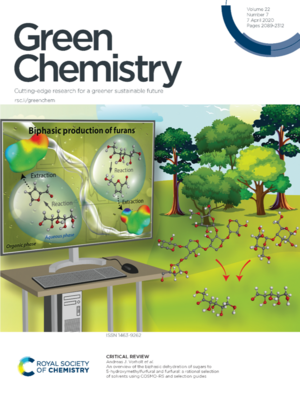The transition to a bio-based economy requires the production of chemicals, fuels and materials from renewable resources, such as lignocellulose. This material is the most abundant raw material on Earth and therefore draws substantial attention in chemical research. Two examples of valuable compounds for the production of such goods are furanic compounds like 5-hydroxymethylfurfural (5-HMF) and furfural, which can be obtained from the dehydration of lignocellulosic sugars like fructose or xylose. The classic single aqueous phase procedure to conduct this reaction leads to undesired side reactions when the products remain in contact with water and acid catalysts, which inevitably leads to a reduced efficiency of the process. This can be prevented using a biphasic approach, whereby an in-situ extraction of 5-HMF or furfural with an organic solvent can be achieved, which enhances the yields.
This motivated Dr. Jesús Esteban, <link>Prof. Walter Leitner (Department of Molecular Catalysis) and <link>PD Dr. Andreas J. Vorholt (Multiphase Catalysis Group Leader) to undertake a considerable effort in critically reviewing the recent achievements in this field, that was lately published in the Royal Society of Chemistry journal Green Chemistry.
"We realized that even though this strategy had already been applied, the choice of solvents in different works appeared to be trial-and-error endeavors rather than selections made on a rational basis," says Jesús Esteban, a postdoctoral researcher in Vorholt’s group and the first author of the mentioned review. "For all of this, our contribution presents a 3-in-1 effort that first gives an extensive overview of the state of the art of the production of 5-HMF and furfural in biphasic media, then covers solvent selection methods from the point of view of application as well as environmental, health and safety considerations and, finally, implements a workflow based on the use of a computational chemistry method like COSMO-RS and solvent selection guides to propose the most promising green solvents for this case."
This critical review work addresses topics of great relevance for Green Chemistry like the production of chemicals from renewable feedstock employing safe and effective chemicals whilst highlighting the importance of following a rational method for the selection of solvents. The importance of this work was also recognized by the editorial board of the journal and thus highlighted on the inside front cover of the latest issue.
Original publication: Esteban, J., Vorholt, A.J., Leitner, W. (2020). An overview of the biphasic dehydration of sugars to 5-hydroxymethylfurfural and furfural: a rational selection of solvents using COSMO-RS and selection guides Green Chemistry 22(7), 2097-2128. <link https: doi.org c9gc04208c>doi.org/10.1039/C9GC04208C

